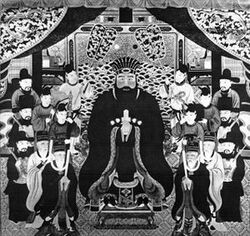Difference between revisions of "Ogo-e"
From SamuraiWiki
Jump to navigationJump to search| Line 5: | Line 5: | ||
Ten such portraits have been confirmed to have existed, from [[Sho En|Shô En]] through [[Sho Iku|Shô Iku]]. All were destroyed in the 1945 battle of Okinawa, but pre-war writings indicate they were richly colored, painted in mineral pigments on paper. Today, these portraits survive only in black-and-white photos by [[Kamakura Yoshitaro|Kamakura Yoshitarô]]. Efforts are being made to reconstruct the techniques or reproduce the portraits. | Ten such portraits have been confirmed to have existed, from [[Sho En|Shô En]] through [[Sho Iku|Shô Iku]]. All were destroyed in the 1945 battle of Okinawa, but pre-war writings indicate they were richly colored, painted in mineral pigments on paper. Today, these portraits survive only in black-and-white photos by [[Kamakura Yoshitaro|Kamakura Yoshitarô]]. Efforts are being made to reconstruct the techniques or reproduce the portraits. | ||
| + | |||
| + | The portraits serve as a valuable resource for understanding royal ceremonial garb of the time. They appear to show that royal robes (''hibenfuku'') grew more elaborate and opulent over time.<ref>''Okinawa bijutsu zenshû'' 5, 318.</ref> | ||
{{stub}} | {{stub}} | ||
| Line 10: | Line 12: | ||
==References== | ==References== | ||
*Plaques on display at [[Shuri castle]].[https://www.flickr.com/photos/toranosuke/15282628908/] | *Plaques on display at [[Shuri castle]].[https://www.flickr.com/photos/toranosuke/15282628908/] | ||
| + | <references/> | ||
[[Category:Ryukyu]] | [[Category:Ryukyu]] | ||
[[Category:Edo Period]] | [[Category:Edo Period]] | ||
[[Category:Art and Architecture]] | [[Category:Art and Architecture]] | ||
Revision as of 21:57, 27 January 2017
- Japanese/Okinawan: 御後絵 (ogoe / ugui)
Ogo-e (lit. "honorable after-portrait") were posthumous portraits painted of each king of the Ryûkyû Kingdom following the king's death.
Ten such portraits have been confirmed to have existed, from Shô En through Shô Iku. All were destroyed in the 1945 battle of Okinawa, but pre-war writings indicate they were richly colored, painted in mineral pigments on paper. Today, these portraits survive only in black-and-white photos by Kamakura Yoshitarô. Efforts are being made to reconstruct the techniques or reproduce the portraits.
The portraits serve as a valuable resource for understanding royal ceremonial garb of the time. They appear to show that royal robes (hibenfuku) grew more elaborate and opulent over time.[1]
References
- Plaques on display at Shuri castle.[1]
- ↑ Okinawa bijutsu zenshû 5, 318.
